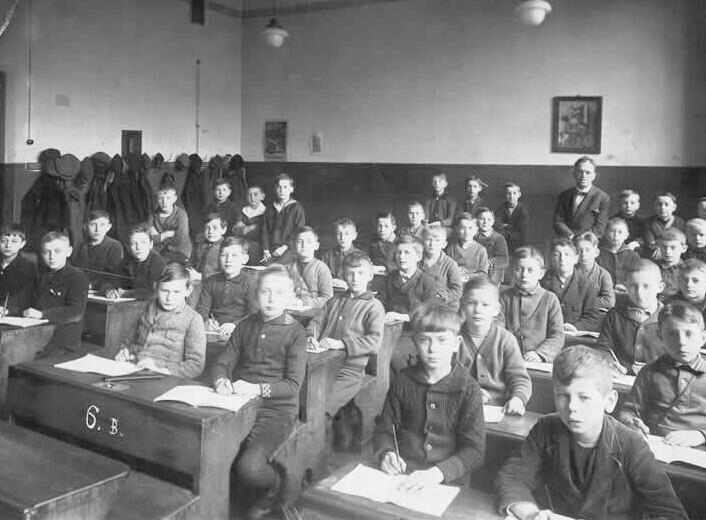
German Education: Academic Standards

Figure 1.--These German students did not have a lot of classroom frills, but German schools had among the gighest academic standards in Europe. I'm not sure what kind of school this was. Notice the desk marked 6B. The class may be the older boys in a primary school. The photograph is undated, but we would guess about the mid-1920s. Notice that there are a few boys wearing sailor suits.
|
Germany in the early 20th century had perhaps the premier education system in the world. Part of the reason for this were high educational standards. Parents that vsalued education and insisted that their children seriously persue their studies along with well prepared and demanding teachers. Another factor was a selective system in which only a small proportion of students advanced beyond the primary level. Academic standards were eroded by the NAZIs during the Third Reich. Academic standards have continued to decline in the post-War era. There is currently a debate in Germany concening both educational philosophy and educational standards. German schools maintained high standards and this was a major factor in the couuntry becoming a center for science and industry. Until the NAZIs, German scientific institutions were some of the premier facilities in the world. German scientists until 1933 led the world in the number of Nobel prize winners. Major reforms were instituted in German eduxation during the post-War era. Up to recent reforms, for example, to study medicine and law at German universities one had to have some knowledge of Latin („das kleine Latinum“ at least, 3–5 years in school/gymnasium) to study these fields. It is difficult to compare academic achievement in different countries. One attempt to do so are the "PISA-Studies“. These assessments at the end of the 20th century show Germany is on the lower ranks, very low ranks in fact. PISA Studies comparing the reading abilities of 14/15 years olds show German children score very low. This has shocked the German public which had thought that German schools were some of the best in the world. A German reader writes, "Our politicians are now heavily discussing what the reason is, the teachers, the system, the parents, the pupils, ... They say always that the others are responsible, typical politicians – and they are not able to really change the system up from the basic mistakes in our present educational system made in the 70s and 80s by the socalled „Achtundsechziger“ (68er) who are now in the governments of the federal state and the German states. Thus I do not see any possibility of improvement in the near future."
HBC-SU

Related Chronolgy Pages in the Boys' Historical Web Site
[Main Chronology Page]
[The 1880s]
[The 1930s]
[The 1940s]
[The 1950s]
[The 1960s]
[The 1970s]
[The 1980s]
Related Style Pages in the Boys' Historical Web Site
[Main school uniform page]
[Main country page]
[Long pants suits]
[Short pants suits]
[Socks]
[Eton suits]
[Jacket and trousers]
[Blazer
[School sandals]
Navigate the Boys' Historical Clothing School Uniform Pages
[Return to the Main German educational philosophy page]
[Main School Uniform Page]
[Australia]
[England]
[France]
[Germany]
[Italy]
[Japan]
[New Zealand]
[Scotland]
[United States]
Navigate the Boys' Historical Clothing Web Page
[Introduction]
[Activities]
[Biographies]
[Chronology]
[Clothing styles]
[Countries]
[Bibliographies]
[Contributions]
[FAQs]
[Glossaries]
[Satellite sites]
[Tools]
[Boys' Clothing Home]
Created: 2:11 AM 6/28/2004
Last updated: 2:11 AM 6/28/2004




